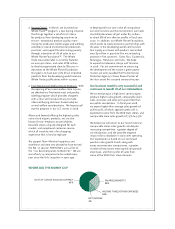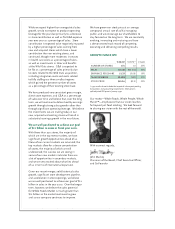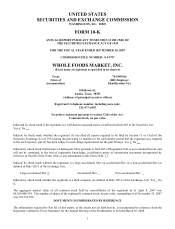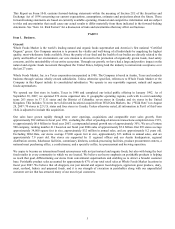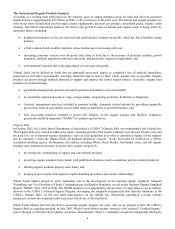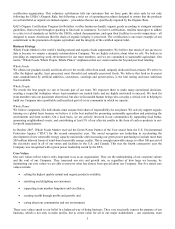Whole Foods 2007 Annual Report Download - page 15
Download and view the complete annual report
Please find page 15 of the 2007 Whole Foods annual report below. You can navigate through the pages in the report by either clicking on the pages listed below, or by using the keyword search tool below to find specific information within the annual report. 9
In addition to these nationally-driven programs, we have a number of store-made and regionally-made fresh items sold under
the Whole Foods Market label. We also offer specialty and organic coffee, tea and drinking chocolates through our Allegro
Coffee Company subsidiary.
• 365 Everyday Value. In 1997, we introduced a line of products under the “365” label emphasizing everyday value.
These products meet our quality standards but are generally less expensive than the alternative products we sell. Our
qualitative and quantitative research indicates that the “365” line is a highly recognized and trusted brand with Whole
Foods Market shoppers.
• 365 Organic Everyday Value. In 2002, we expanded our private label program with the introduction of our “365
Organic” line. The “365 Organic” brand provides all of the benefits of organic food at reduced prices. In 2003, we
expanded this program into non-grocery departments, including a successful line of organic fresh vegetables, and in
2006, we began the process of rebranding our Whole Kids Organic line, first introduced in 1998, under the “365
Organic” label with some new kid-friendly designs.
• Whole Brands. In 2004, we introduced a new family of “Whole Brands,” each aligned with department-specific quality
and sourcing standards. Included under the “Whole Brands” umbrella are “Whole Kitchen” for pre-packaged fresh and
frozen grocery, “Whole Treat” for frozen desserts, cookies and candies, “Whole Catch” for pre-packaged fresh and
frozen seafood items, “Whole Fields” for produce and produce support items, “Whole Pantry” for items such as herbs,
spices and condiments, “Whole Creamery” for cheeses, “Whole Ranch” for pre-packaged fresh and frozen meat, and
“Whole Paws” for tasty and healthful pet food. These brands go beyond the basics, offering unique items, including
innovative formulations, that embody our high quality standards and supplement our base value line of “365” and “365
Organic” items. Items within “Whole Brands” share a consistent logo format and packaging so that our customers know
each is part of a greater family.
At our Whole Foods Market locations, private label sales in grocery and nutrition accounted for approximately 18% of our
total retail sales in those product categories in fiscal year 2007, up from 16% in fiscal year 2006. Total private label sales
across all teams accounted for approximately 9% of our retail sales in fiscal year 2007, up from 8% of our retail sales in
fiscal year 2006, reflecting the roll-out of approximately 550 new items in fiscal year 2007. We believe our private label
sales could grow to a much higher percentage of our sales over time, as we continue to focus on the rapid development and
growth of our product lines.
Economic Value Added
We use Economic Value Added (“EVA”™) as a basis for our business decisions and for determining incentive
compensation. In its simplest definition, EVA is equivalent to net operating profits after taxes minus a charge for the cost of
invested capital necessary to generate those profits. We believe one of our core strengths is our decentralized culture, where
decisions are made at the store level, close to the customer. We believe this is one of our strongest competitive advantages
and that EVA is the best financial framework that team members can use to help make decisions that create sustainable
shareholder value.
We use EVA extensively for capital investment decisions, including evaluating new store real estate decisions and store
remodeling proposals. We only invest in projects that we believe will add long-term value to the Company. The EVA
decision-making model also enhances operating decisions in stores. Our emphasis is on EVA improvement, as we want to
challenge our teams to continue to innovate and grow EVA in new ways. We believe that opportunities always exist to
increase sales and margins, to lower operating expenses and to make investments that add value in ways that benefit all of
our stakeholders. We believe that focusing on EVA improvement encourages continuous improvement of our business.
Over 750 leaders throughout the Company are on EVA-based incentive compensation plans, of which the primary measure is
EVA improvement. EVA-based plans cover our senior executive leadership, regional leadership and the store leadership
team (store team leaders and assistant store team leaders) in all stores. Incentive compensation for each of these groups is
determined based on relevant EVA measures at different levels, including the total Company level, the regional level, the
store or facility level, and the team level. We believe using EVA in a multi-dimensional approach best measures the results
of decisions made at different levels of the Company. We expect EVA to remain a significant component of our
compensation structure throughout the Company in the coming years.
Information about our EVA financial results is not presented because of rules adopted by the Securities and Exchange
Commission (“SEC”) regarding non-GAAP financial measures. Additional information about our EVA financial results is
available on our corporate website at www.wholefoodsmarket.com but is not incorporated by reference into this Form 10-K.


